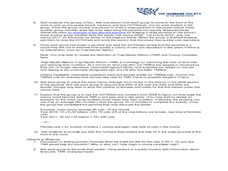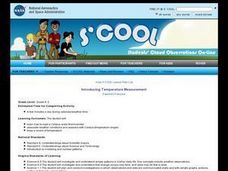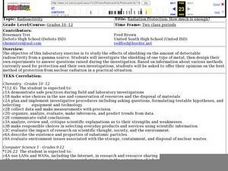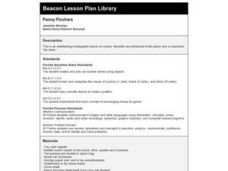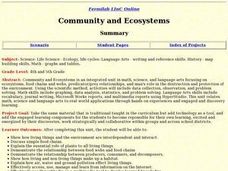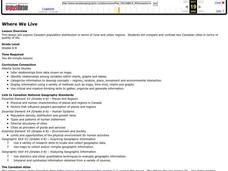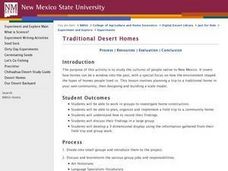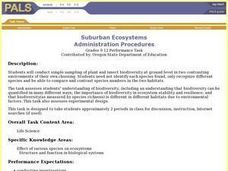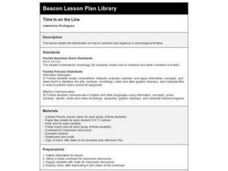Curated OER
Kites: Patang - The Indian Fighter Kite
Students investigate the history of fighter kites and build their own. In this aeronautics lesson, students discover how other countries utilize fighter kites and where they originated. Students create their own fighter kites in class...
Curated OER
The Tale of the Feral - Care and Multiplication of Feral Cats
Students differentiate between a feral cat and a domesticated cat. In this cat lesson plan, students use the scientific method, calculate averages, solve story problems, and learn how a caretaker can help a feral colony live safely.
Curated OER
Introducing Temperature Measurement
Students explore temperature and use Celcius thermometers to measure and graph the temperature in the classroom daily. They estimate what they think the temperature might be and then find the actual temperature in the room.
Curated OER
Black Hole Lesson
Tenth graders experiment with detection techniques for black holes by modeling the rotation of galaxies with larger and larger masses in the center. They discover while some events cannot be directly observed they may be observable in...
Curated OER
Did Somebody Say...? Where to Work?
Students conduct research on four fast food restaurants to determine where they might apply for a job. They conduct research on hourly rate, working conditions, and benefits, construct a spreadsheet with a graph, and present their...
Curated OER
Make Your Own "Weather" Map
Students develop and apply a variety of strategies to solve problems, with an emphasis on multi-step and non-routine problems. They acquire confidence in using mathematics meaningfully.
Curated OER
Weather Graphs
First graders use their knowledge of weather symbols to organize and construct a graph of the daily weather for one month. Each student have a chance to give the daily weather report using Sammy's Science House Computer Software.
Curated OER
Are things Really More Expensive Today?
Young scholars explore the topics of inflation and deflation within the economy. The Consumer Price Index is used to contrast the price of goods today with that of years past.
Curated OER
Packing Materials
Students observe the effects of water on four different packing materials to determine which ones are more soluble. They then decide which material would be a good packing material to use for the environment and which may be a bad...
Curated OER
Pendulum
Sixth graders are instructed on how to create a pendulum and measure the periodicity of the pendulum, using four different combinations of string. They are asked which influences the time more- the length of the string or the weight at...
Curated OER
Hurricane Tracking
Students access the Internet to find information on current hurricanes. They get locations, speeds, and air pressures and then plot the location of the hurricane on a hurricane-tracking map. They also access the FEMA website to solve...
Curated OER
How Deep is the Ocean
Students predict and then analyze the layout of the tectonic plates that form the ocean's floor using mapping skills and Inquiry based problem solving, They compare the depth of various regions in the ocean with the geologic age to...
Curated OER
The Life and Times of Tomie dePaola
First graders research information about the author Tomie dePaola. In this author studies instructional activity, 1st graders use the computer to find information about Tomie dePaola's life and writing accomplishments. Students create...
Curated OER
RADIATION PROTECTION: HOW MUCH IS ENOUGH?
Young scholars study the effects of shielding on the amount of detectable radioactivity from a gamma source. They investigate the shielding of one type of metal, then design their own experiments to answer questions raised during the...
Curated OER
Penny Pinchers
Students, by participating in a classroom toy store, are introduced to the penny.
Curated OER
Community and Ecosystems
Students complete a unit of lessons on ecosystems. They participate in online activities, create a diorama, write journal entries, and develop a Hyperstudio multimedia project on a selected ecosystem.
Curated OER
Where We Live
Students analyze Canada's population distribution. They access online information to gather demographic information about two Canadian cities. They compare and contrast the quality of life in the two cities and present their findings.
Curated OER
Traditional Desert Homes
Learners go to a traditional style desert home and then build their own model of a home to scale. In this desert home lesson plan, students conduct their research in New Mexico.
Curated OER
A Cut Above the Rest Administration Procedures
Students analyze how the Law of Conservation of Energy applies to the design and use of scissors. Working in groups, they determine the output work for a standard pair of scissors.
Curated OER
Deliver
Students measure the mass, volume, length and area of various objects. They are assigned a letter. The task is assesses students' abilities to make simple observations and measurements.
Curated OER
Instruments and Measurement
Students circulate through stations to determine the proper instrument to make a certain type of measurement. They must make measurements of mass, volume, length, area, electrical current, temperature and force.
Curated OER
Suburban Ecosystems
Students conduct simple sampling of plant and insect biodiversity at ground level in two contrasting environments of their own choosing. They recognize and record different species then compare and contrast species numbers in the two...
Curated OER
Time Is On the Line
Middle schoolers observe how to develop a chronological timeline. They construct a timeline, placing six significant events in chronological order, using symbols and pictures to correspond with the events and dates.
Curated OER
Oh Deer!
Students discuss the components necessary to keep animal populations alive . Then they participate in a game where they interact as deer, food, water, and shelter. The activity demonstrates that nature is not static, but changes with the...



